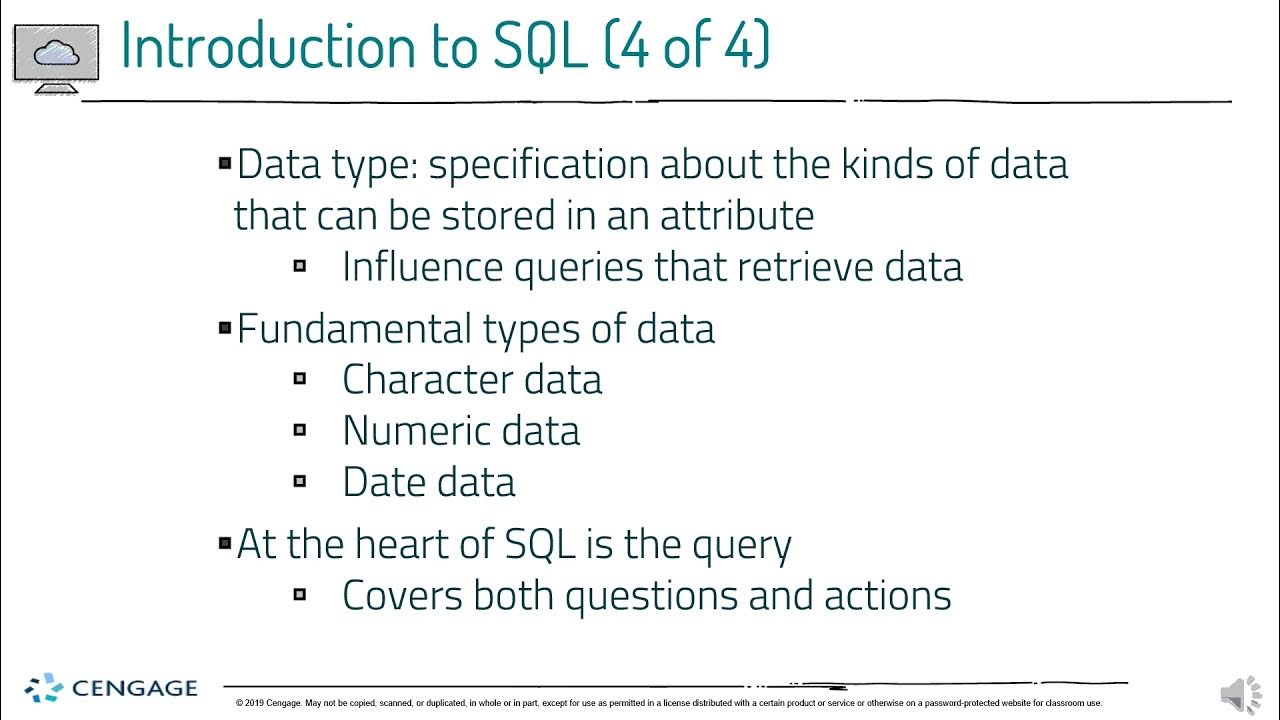What is Database & SQL?
Summary
TLDRThis tutorial introduces the fundamentals of databases and SQL. It begins by explaining what data is and the importance of organizing data in databases for easier management. A database management system (DBMS) is described as software that allows users to access, manipulate, and manage data efficiently. The tutorial outlines four types of DBMS: hierarchical, network, relational, and object-oriented. SQL (Structured Query Language), the standard for interacting with relational databases, is explained with examples. Popular DBMS like MySQL, Oracle, and Microsoft SQL Server are mentioned, along with SQL's role in querying and maintaining databases.
Takeaways
- 📄 Data is defined as facts or information related to any object, including personal details and digital files.
- 🗂️ A database is a systematic collection of organized data, facilitating easier management.
- 💻 DBMS (Database Management System) is a software that allows users to access, manipulate, and represent data in a database while controlling access.
- 📞 Examples of DBMS usage include online telephone directories, electricity service providers, and social media platforms like Facebook.
- 📚 The concept of DBMS has been around since the 1960s, with the first DBMS being Charles Bachman's Integrated Data Store (IDS).
- 🌐 DBMS has evolved over time, with four major types: Hierarchical, Network, Relational, and Object-Oriented.
- 🌳 Hierarchical DBMS uses a parent-child relationship for data storage, structured like a tree.
- 🔗 Network DBMS supports many-to-many relationships, resulting in complex database structures.
- 📊 Relational DBMS organizes data in tables and is the most popular type, with examples like MySQL, Oracle, and Microsoft SQL Server.
- 🔄 Object-Oriented DBMS allows storage of data in the form of objects with attributes and methods, like PostgreSQL.
- 🔎 SQL (Structured Query Language) is the standard language used for managing relational databases, allowing for data insertion, searching, updating, and deletion.
Q & A
What is data in simple terms?
-Data can be facts related to any object, such as your name, age, height, weight, or even files like images and PDFs.
What is a database?
-A database is a systematic collection of data that is organized, making data management easier.
What is a Database Management System (DBMS)?
-A DBMS is a collection of programs that allows users to access, manipulate, and represent data, while controlling access to the database by various users.
Can you give an example of DBMS usage?
-An online telephone directory uses a DBMS to store contact details like names and phone numbers. Other examples include billing management by electricity service providers and Facebook's data management of users' activities.
What was the first DBMS, and when was it implemented?
-The first DBMS was Charles Bachmann's Integrated Data Store (IDS), which was implemented in the 1960s.
What are the four major types of DBMS?
-The four major types of DBMS are Hierarchical, Network, Relational, and Object-Oriented DBMS.
What is a Hierarchical DBMS?
-A Hierarchical DBMS uses a parent-child structure for storing data, resembling a tree with nodes as records and branches as fields. It is rarely used nowadays.
How does a Network DBMS differ from a Relational DBMS?
-A Network DBMS supports many-to-many relationships, resulting in complex structures, while a Relational DBMS organizes data in tables and typically does not support many-to-many relationships.
What is SQL, and what is its purpose?
-SQL (Structured Query Language) is the standard language for managing and interacting with relational databases. It is used to insert, search, update, and delete database records, as well as for optimizing and maintaining databases.
Which types of DBMS use SQL, and how do SQL implementations differ?
-Relational DBMSs like MySQL, Oracle, and Microsoft SQL Server use SQL. While the SQL syntax is mostly similar across these systems, some databases use proprietary SQL syntax with slight variations.
Outlines

This section is available to paid users only. Please upgrade to access this part.
Upgrade NowMindmap

This section is available to paid users only. Please upgrade to access this part.
Upgrade NowKeywords

This section is available to paid users only. Please upgrade to access this part.
Upgrade NowHighlights

This section is available to paid users only. Please upgrade to access this part.
Upgrade NowTranscripts

This section is available to paid users only. Please upgrade to access this part.
Upgrade NowBrowse More Related Video
5.0 / 5 (0 votes)





